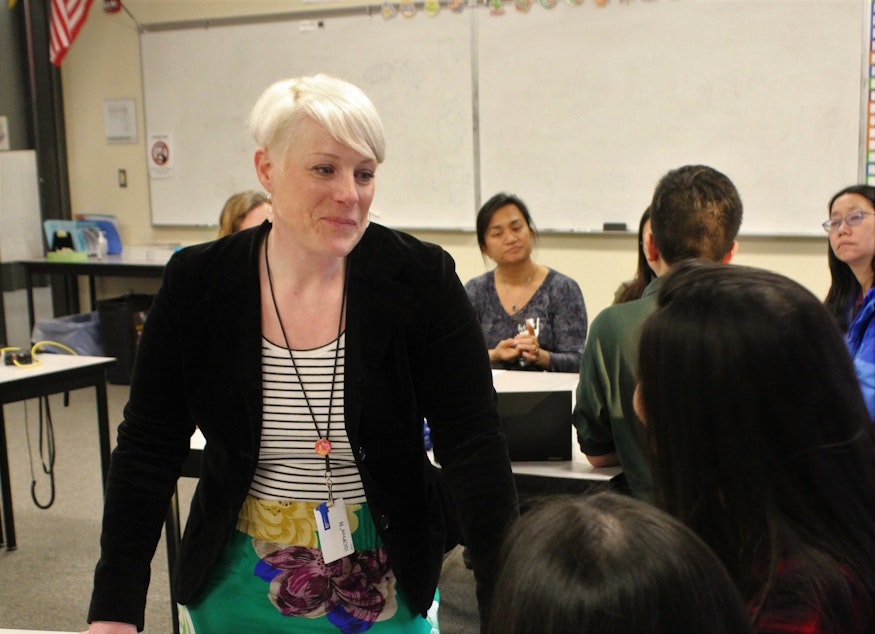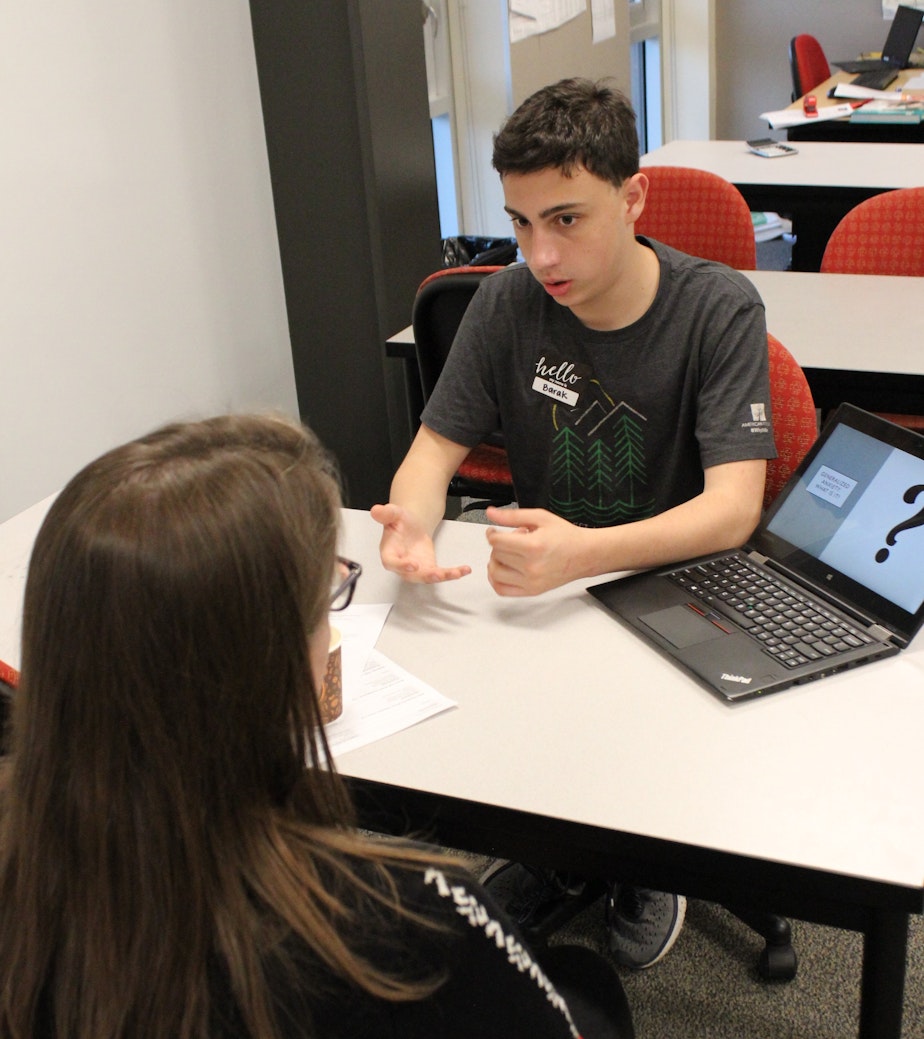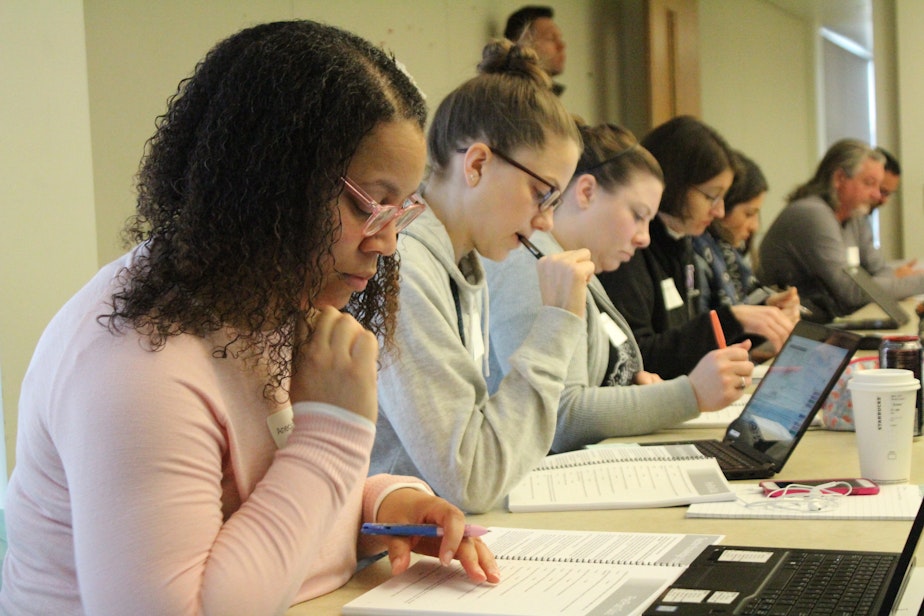The kids are not alright. High schools grapple with rising rates of mental illness

At Sammamish High School in Bellevue, it’s a big night for the 10th grade.
The students sit around tables with their laptops, presenting their research projects about mental health during the school's Health and Wellness Night.
Chanwit Thepveera studied post-traumatic stress disorder.
“Forty percent of children and teens go through one traumatic event in their lives,” he told a table of parents and visitors. That can include physical violence, war, sexual abuse — witnessing it or experiencing it themselves.
Other students researched depression, anxiety, eating disorders, and suicide.
Students here learn about mental health in 10th grade health class. The hope is that by studying these illnesses, students will recognize signs and symptoms in themselves, and seek help if they need it.
“Sophomore year, when I really get into teaching around mental health and we start really digging into what different mental health conditions involve or disorders, students are realizing, that’s me,” said Karissa Stay, a Sammamish High School health teacher who teaches a mental health curriculum to all 10th graders.
R
ates of depression, anxiety, suicidality, and other mental health disorders among teens have been on the rise in recent years.
Karissa Stay has been a teacher for well over a decade. She said the trend is hard to miss.
It’s happened at the same time that academic demands on students have increased. This is a generation that has grown up constantly being tested and evaluated. Students at Sammamish High School take seven classes, including mandatory AP classes. For many, there are sports, extra-curricular activities, service projects, and after-school jobs.

Stay said it seems like there is very little downtime.
“Studies show that teenage stress right now is not just higher than their parents stress when they were teens," she said. "It’s higher than their parents' current stress level. Our teens are more stressed than their parents,” she said.
If you put a bunch of students around a table, they pretty much agree.
"Students can get really seriously anxious, they can suffer from depression, and it's difficult for teachers to manage the needs of every single student," said Barak Horowitz, a 10th grader.
"I don’t personally get depressed," said Alexa, another student. "I get stressed and worried and have a lot of anxiety. It’s just something that ... it just gets really hard."
M
ental health professionals said the increase in mental health disorders can be attributed in part to better understanding of mental illness so more kids are getting diagnosed and getting help.
But something else is going on as well.
David Downing is a licensed mental health provider and chief operating officer of Youth Eastside Services, which provides mental health services to the eastside, including to schools like Sammamish High School.
Downing said a decade ago, most of the kids that YES served had suffered some kind of trauma. Now they are seeing a much broader cross-section of kids from all socioeconomic groups. And they are experiencing more acute symptoms than before.
"At one time, we would have maybe a couple of kids in a six month period that we would need to get them connected to the hospital for inpatient psychiatric hospitalization due to suicidality," he said. Now, there are weeks when there are four or more kids who require hospitalization.

A recent study in JAMA Pediatrics found that the number of kids under 18 who presented to emergency rooms with suicidal thoughts or actions doubled between 2007-2015.
So far there is no consensus among mental health professionals as to why this trend is occurring. In addition to increased academic expectations, experts have pointed to a host of other possible causes—including screens and social media, bullying, economic worries, and helicopter parenting.
According to Downing, many factors are hitting this generation all at once.
"You take all of that together and there’s just this profound difference that young people are facing now," he said. "I don’t think a lot of adults necessarily understand the complexity that young people are under nowadays."
A
t Sammamish High School, there is one other thing weighing on people's minds. A student here recently died by suicide.
Karissa Stay said the impact on the school has been incalculable.
Emma, a 10th grader, said she didn't know the student, but her death made many people realize that they have to take better care of their fellow students.
"You never know how they might be feeling that day. Like, they like they could be on the edge and you saying one compliment out of the blue could change their whole day," Emma said. "People just need to be kind. Which doesn't happen enough."
The Bellevue School District is currently piloting a new suicide prevention curriculum called SOS, or Signs of Suicide. They plan to roll it out eventually to all middle and high schools in the district.

Sammamish High School has a part-time mental health counselor on site, and health teacher Karissa Stay says kids often come to her if they are struggling. At the recent Health and Wellness Night, a number of community mental health providers set up tables to let parents know what other services are available.
Recently, a team of Sammamish High School teachers and staff attended a suicide prevention workshop at the University of Washington presented by the Jordan Binion Project.
Olivia, a 10th grader, said kids need to know that they can get help if they need it.
"There are people who love you and people who want to help you," she said. And kids need to understand that their lives are worthwhile. "You are beautiful the way you are and you are enough."
Listen to an extended conversation between Deborah Wang and Bill Radke on the shortage of mental health services in the state's high schools on KUOW's The Record.
Read more: 4 teens died by suicide in Seattle area in recent days
Read more: As youth suicides increase, these teens want to save lives
Deborah Wang is spending the year doing stories on adolescents and mental health as part of a Rosalynn Carter Mental Health Journalism Fellowship. If you have a story you would like to share with Deborah, please email youthmentalhealth@kuow.org.




